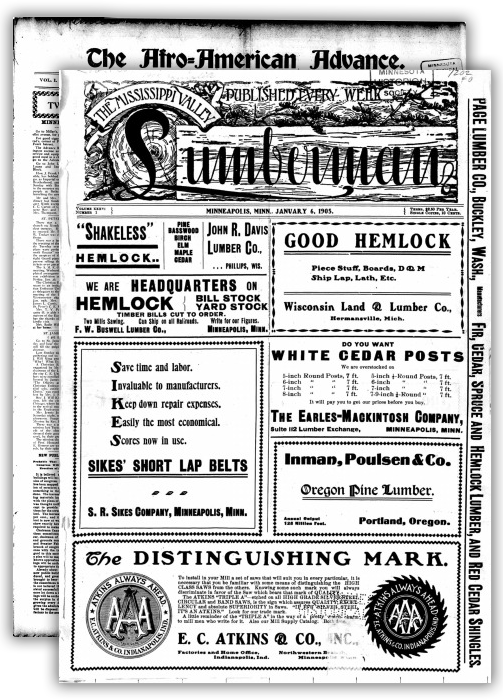
hub
Introduction
titles
About the titles
corporations foundations
Search the Newspapers
hub-faq
F.A.Q.
Choose a Menu
-
hubIntroduction
-
titlesAbout the titles
-
corporations foundationsSearch the Newspapers
-
hub-faqF.A.Q.
Backbone / The Public Weal
Backbone (St. Paul, Minn.; Minneapolis, Minn.) 1897-1906 Browse the title
The Public weal (Minneapolis, Minn.) 1906-1908 Browse the title
Backbone (1897-1906), and its successor, the Public Weal (1906-1908), official organs of the Minnesota Prohibition State Central Committee, represented the Prohibition Party's attempt to reach Minnesota residents in support of its candidates for local, state, and national offices. The inaugural issue (January 1897) states its mission: "The saloon must go. It can only be destroyed through the agency of a political party committed to that purpose . . . . We aim to reach every Prohibitionist in Minnesota. But still more do we desire to reach thousands of candid men who hate the saloon as much as we, but who in their blindness are perpetuating it by giving the support of their ballot to parties committed by their platforms or record, or both, to the license policy."
A monthly publication, Backbone began as a two-column paper, eventually going to four columns. Each issue was four pages, except special election editions that contained eight pages. The paper covered local, regional, national, and international news of the prohibition movement. Articles recounted personal stories, candidate biographies, election successes and failures, legislative plans, and the activities of various ethnic (especially Scandinavian) temperance organizations. A few illustrations and an increasing number of local advertisements characterized the paper as it aged. By 1904, it claimed a circulation of 25,000 copies at a subscription price of 25 cents per year.
The paper's masthead notes addresses only in St. Paul at first, then in both St. Paul and Minneapolis. Its sole editor and general manager was George F. Wells (1853-1934), a Methodist pastor and long-time temperance advocate. All issues also identify W.G. [Willis Greenleaf] Calderwood (1866-1956), secretary of the State Prohibition Committee and a senatorial candidate in 1916 and 1918, as a contact person.
In the April 1906 issue, the managers announced plans to move to semi-monthly publication, pending adequate new subscriptions. However, the May 1906 issue appeared as a monthly, under the same editorship and containing the same features, but with a new title, the Public Weal. Volume and numbering continued uninterrupted, and the masthead also contained "Continuing BACKBONE" to emphasize the sequence. The editors explained the need for a new name: "Within the limits of our columns we now propose to discuss and champion related reforms and to labor for the physical, mental and moral welfare of all the people. We shall strive for a nobler citizenry, a grander nation, a better day. THE PUBLIC WEAL expresses this idea better than any other title that comes to our mind. It is expressive of the purest, broadest and highest in the thinking and living of the people of today."
Although the conceptual mission of the Public Weal was enlarged, the vast majority of the articles continued to be related to the temperance movement and its political and educational endeavors. The four-page, four-column format of Backbone continued with illustrations and local advertisements. George Wells continued as editor, with offices in Minneapolis. The dream of a semi-monthly paper did not materialize, and the April 1908 issue reported that it would be the last number under that name. With the same positive outlook that accompanied its appearance in 1906, the Public Weal's editor announced the paper's combination with the South Dakota State Prohibition Committee's Beacon Light under the new name Northwestern Patriot with offices in both Minneapolis and Brookings, South Dakota.
Minnesota Digital Newspaper Hub
The Minnesota Digital Newspaper Hub is a searchable website from the Minnesota Historical Society that makes millions of pages of Minnesota newspapers available online.
The Hub contains geographically and culturally diverse newspapers published between 1849 and today. Due to potential copyright restrictions most issues published after 1977 can only be accessed from the Gale Family Library at the Minnesota History Center.
The Minnesota Digital Newspaper Hub incorporates Minneapolis Tribune titles previously found on a stand-alone website, foreign-language titles, and much more, with new titles and date ranges continuously being added.
The Minnesota Historical Society's newspaper digitization program is made possible through support from the National Endowment for the Humanities and the National Digital Newspaper Program (NDNP), the Legacy Amendment's Arts and Cultural Heritage Fund through the vote of Minnesotans on Nov. 4, 2008, SELCO (Southeastern Libraries Cooperating) through a grant from the Minnesota Arts and Cultural Heritage Fund for Libraries, and many other organizations and individual donors.
Material in the Digital Newspaper Hub may be protected by copyright law (U.S. Code Title 17).
Looking for more information on MNHS digital newspaper collections? Visit Digital Newspapers at MNHS
